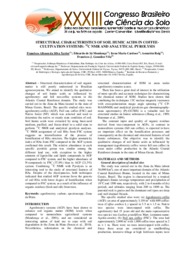Structural characteristics of soil humic acids in coffee-cultivation systems: 13C NMR and analytical pyrolysis.
Structural characteristics of soil humic acids in coffee-cultivation systems: 13C NMR and analytical pyrolysis.
Author(s): XAVIER, F. A. da S.; MENDONÇA, E. de S.; CARDOSO, I. M.; ROIG, A.; GONZÁLEZ-VILA, F. J.
Summary: Structural characterization of soil organic matter is still poorly understood in Brazilian agroecosystems. We aimed to identify the qualitative changes of soil humic acids as influenced by agroforestry- and full sun-coffee systems in the Atlantic Coastal Rainforest domain. The study was carried out in the Zona da Mata located in the state of Minas Gerais, Brazil. The specific studied sites were:agroforestry-coffee (AGF), Full sun coffee (FSC) and Native forest (NF) which was selected and used to determine the native or steady state condition of soil. Soil humic acids were extracted by using basic-acid medium, purified, and freeze-dried to a solid state to perform 13C NMR and analytical pyrolysis analyses. 13C NMR assignment of soil HAs from FSC system suggests an intensification of the process of humification of HAs structure. The higher aromaticity index of HAs from FSC compared to the AGF system confirmed this result. The relative abundance in each specific pyrolitic group was similar among the different land use, with exception to the higher amounts of lignin-like and lipids compounds in AGF compared to FSC system, and the higher abundance of N-compounds in FSC (37,0%) than in AGF (21,5%) system. Combining 13C NMR with Pyrolysis is an interesting tool to the study of structural features of HAs. Despite of the discrepancies, both techniques indicated that studied AGF systems favor the genesis of soil HAs with lower degree of humification when compared to FSC system, as a result of the influence of organic residues (fresh and old) from trees.
Publication year: 2011
Types of publication: Paper in annals and proceedings
Unit: Embrapa Cassava & Fruits
Keywords: Zona da mata, agroforestry, carbon, spectroscopy
Observation
Some of Embrapa's publications are published as ePub files. To read them, use or download one of the following free software options to your computer or mobile device. Android: Google Play Books; IOS: iBooks; Windows and Linux: Calibre.
Access other publications
Access the Agricultural Research Database (BDPA) to consult Embrapa's full library collection and records.
Visit Embrapa Bookstore to purchase books and other publications sold by Embrapa.

